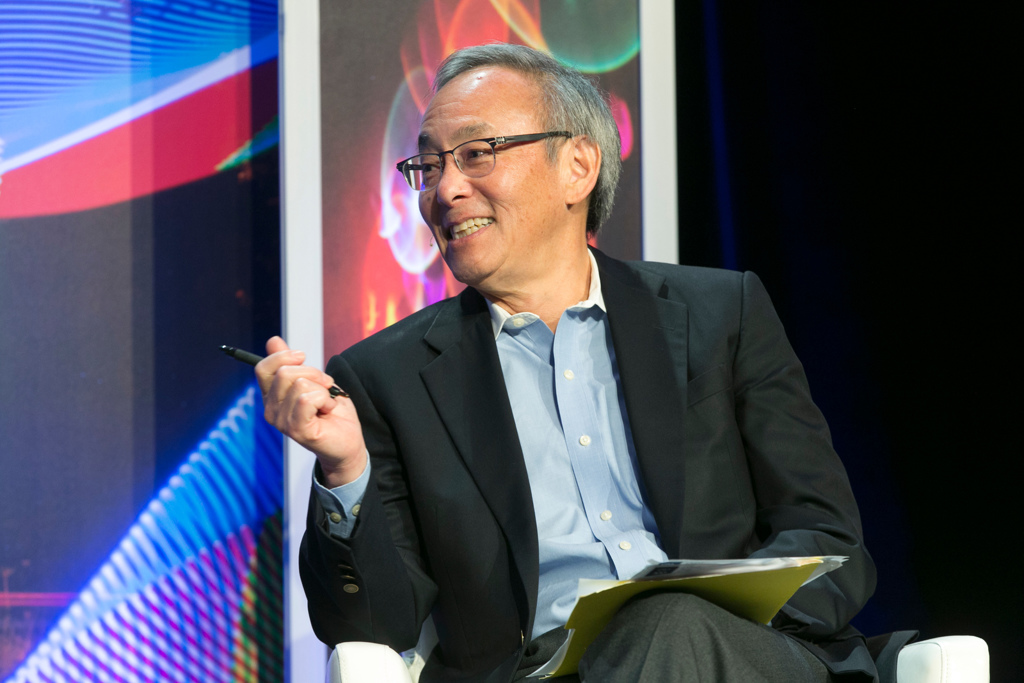Steven Chu

Steven Chu at the Light the Future program for CLEO 2016 © Eric Slomanson
Nobel Laureate and OSA Honorary Member Steven Chu was born in St. Louis, Missouri on 28 February, 1948. He earned undergraduate degrees in mathematics and physics from the University of Rochester in 1970, a Ph.D. in physics from the University of California at Berkeley in 1976, and was a postdoctoral fellow at UC Berkeley from 1976 to 1978, when he joined AT&T’s Bell Labs.
While at Berkeley Chu changed research directions, moving from theoretical physics to experimental physics. His time at Bell Labs was particularly fruitful in this regard providing the basis for his experiments in laser cooling of atoms.
When he moved to Stanford University in 1987, he served as a professor of physics and applied physics, and held a number of administrative posts. During this time Chu focused on his most important work in polarization gradient cooling, the demonstration of the atomic fountain clock, the development of atom interferometers and a new method of laser cooling based on Raman pulses. Chu also set about to manipulate individual DNA molecules with so-called "optical tweezers" by attaching micron-sized polystyrene spheres to the ends of the molecule. His experiments work and over the years Chu and his students have discovered that identical molecules in the same initial state will choose several distinct pathways to a new equilibrium state. This "molecular individualism" was never anticipated in previous polymer dynamics theories or simulations.
In 1994, Chu received the William F. Meggers Award "for pioneering work in manipulation, cooling, and trapping of neutral particles by laser light, and for the first optical spectroscopy of the short-lived laptonicatoms, positronium and muonium."
In 2004 Chu moved from Stanford to become director of Lawrence Berkeley National Laboratory. He focused the laboratory’s scientific resources on energy security and global climate change, in particular the production of new fuels and electricity from sunlight through non-food plant materials and artificial photosynthesis. At the same time he reinforced the Lab’s historic leadership in energy-efficient technologies and climate science.
In part because of his commitment to energy research, Chu was nominated and sworn in as the 12th U.S. Secretary of Energy in 2009.
In addition to the 1997 Nobel Prize in Physics, shared with Claude Cohen-Tannoudji and William D. Phillips for developing methods to cool and trap atoms with laser light, Chu’s numerous awards include the APS Arthur Schawlow Prize for Laser Science, the Alexander von Humboldt Foundation’s Senior Scientist Award, a Guggenheim Fellowship, and membership in the National Academy of Sciences, the Academica Sinica, the American Philosophical Society, the Chinese Academy of Sciences, and the Korean Academy of Sciences and Technology.
Chu is internationally recognized as a proponent of increased government investment in advanced energy research, and he has been a leader in national and international studies including the influential InterAcademy Council report Lighting the Way: Toward a Sustainable Energy Future, the National Academy’s Rising Above the Gathering Storm: Energizing and Employing America for a Brighter Economic Future, and the National Academies’ ongoing study, America's Energy Future.
Chu is a member of the American Academy of Arts and Sciences’ committee on Alternative Models of Federal Funding of Science, and is on the Council on Competitiveness’ Steering Committee of the Energy Security, Innovation and Sustainability Initiative.
In 2013, OSA awarded Chu with its Advocate of Optics Award, for his consistent support of science, optics and photonics and as an enthusiastic advocate for science policy issues, with particular regard to the advancement of the science of light.
Chu continues to be an active member of the Optical Society, speaking a many of its conferences and events.
The atoms become like a moth, seeking out the region of higher laser intensity.
Multimedia
Document Created: 26 Jul 2023
Last Updated: 28 Aug 2023
